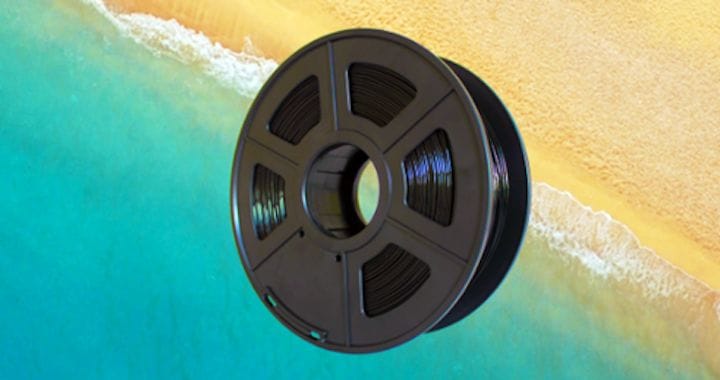![Is recycling ocean waste really feasible? [Source: Clean Currents]](https://fabbaloo.com/wp-content/uploads/2020/05/ocean-ov_result_img_5eb0a2bb215dd.jpg)
I’m looking at a new Kickstarter project that hopes to manufacture 3D printer filament from stray plastic in the Caribbean.
The project, by Washington DC-based Clean Currents, has the tagline: “We Connect Designers And Manufacturers To Cheap, Useful Forms Of Recycled Ocean Plastic.”
This is an admirable goal, as the problem of micro plastics in our planet’s waters is a very serious issue that is only recently gaining attention. These micro plastics are tiny particles of random plastic that erode off the zillions of plastic items discarded in water, or on land and eventually make their way into water. There’s even a gigantic “island” of plastic floating in the Pacific, called the “Great Pacific Garbage Patch”.
The theory is that Clear Currents will collect discarded plastic and reform it into usable 3D printer filament and thus work toward resolving the issue.
![A waste dump in Haiti where recyclable plastic bottles may be obtained [Source: Clean Currents]](https://fabbaloo.com/wp-content/uploads/2020/05/image-asset_img_5eb0a2bb7f746.jpg)
Their strategy is to collect stray bottles from a notorious Haitian dump and recycle them to obtain their PET material, which is then extruded into usable 3D printer filament. They say:
“Every year over 18 Billion pounds of plastic empty into our oceans, adding onto the 5 trillion pieces already there. We’re beginning to see this pollution creep into our water supply and our food in the form of ‘micro-plastics’. These materials take centuries to decompose and once they break up, we lose track of them forever. That’s why it’s so important we act as soon as possible, this problem has a time limit.”
And
“The entirety of Haiti imports roughly 40,000 pounds of plastic each day. The first goal for our Haiti operation is to equal that amount in recovery: exporting 40,000 pounds of plastic every day. Surprisingly, this would only require one shipping container of our recycled material leaving the port every 24 hours. This is absolutely achievable! With our mixture of recovery methods like collection centers, beach sifters, river skimmers, and trawlers we project being able to reach this 40,000 lbs/day goal within 3 years.”
While I greatly admire their goal and enthusiasm, I am extremely skeptical of this project for a number of reasons. Let’s go through some thoughts.
Today’s 3D printer filament absolutely must be of the highest quality. The industry has now passed through the stage where vendors marketed low-cost filament that simply did not work in many machines. Now users are far less tolerant of bad filament because they want their prints to succeed and not waste time, energy and materials. Therefore filament manufacturers must employ very expensive equipment, facilities and quality control systems to produce this material.
The volume of material they describe is entirely infeasible if intended to be 3D printed. Today’s 3D printers typically can barely print 250g per day. Their figure of 40,000lbs (18,000kg) would require over 70,000 3D printers to be run continuously each and every day forever – and they would all have to be using their particular brand of PET material.
We know that PET is not the most popular material used in 3D printing. According to 3D Hubs’ most recent trends report, PETG is used only 6% of the time. Applying this to the previous calculation suggests that there would have to be 1.2M 3D printers in operation, with 6% going full blast on PET filament.
That simply is not going to happen. There are not that many operational 3D printers in the world and won’t be within a few years. While we may approach that number in the total cumulative number of machines sold, the number actually still in operation will be far less.
Thus I really don’t think this project is effective as a means to clean up the oceans. The amount of material appearing in the oceans is more or less proportional to the amount of plastic used in the entirety of manufacturing. Thus to get it out, you’d have to almost literally switch most manufacturing over to recycled materials, well past 3D printing use.
The Clean Currents project is only focusing on PET bottles and all the other plastic trash remains on the Haitian site, ready to be washed into the sea. I am not certain what percentage of the waste is bottles, but there will surely be vast amounts of non-PET materials present.
By the way, the amount of materials used in 3D printing is dwarfed by the amount of materials used by other manufacturing processes. If I truly wanted to clean up the oceans of plastic, I would look to other processes rather than starting with 3D printing.
Securely burying the Haitian material would likely be a cheaper, faster and more effective method of avoiding ocean pollution, and would handle ALL types of plastic present in that location, rather than just the PET from bottles.
As for the filament, I am sure that some 3D printer operators would buy some of this material, if only as a charitable transaction. But that is no way to run a sustainable business.
Via Kickstarter











An inventive designer has developed a method for producing 3D paper objects using recycled paper and 3D printed molds.